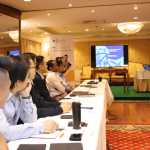
Big Pipes, Big Platforms, Big Trends, Big Transformations
Most of us in the international connectivity world are seeing data demand soaring. It’s so pronounced that even huge pieces of newly installed intercontinental subsea cable want to maximize their potential and upgrade as soon as possible. For example, the transpacific Hawaiki system announced it was installing technology upgrades from Ciena a few months after its initial switch on. Hawaiki’s resulting capacity will be around 67Tbps, an astonishing 53 percent increase from its previous capability.
There are many cable systems planned and in midconstruction, with most activity going live in our region for the same reasons. Likewise, there are many competitive systems on the same route; progress is rapid. In September, the INDIGO subsea cable connecting Australia and South East Asia landed in Perth.
Not surprisingly, international capacity growth has actually accelerated recently in spite of well documented price declines in the industry, reported TeleGeography.
The talk is of sustained big drivers for this activity, and more drivers heading into the future. Consumer and business broadband needs apart, some big trends are driving interconnection, according to Equinix. Driving trends include digital business, urbanization, cybersecurity, data compliance, and business ecosystems.
Ericsson has weighed in with some of its own views on likely transformations inside and outside the industry including: zero touch behaviors like Internet of Skills, adaptable cyber systems, trust technologies, and ubiquitous radio.
No field looks left behind in what appears to be a global rollout of capabilities. In carrier services, SD-WAN gives the impression of a very hot topic for many major service providers. If you need an introduction on the subject, check out this summary from Zenlayer.
Big pipes and big trends clearly need each other. With these trends occurring, the stage is well set for intensive discussion and networking at PTC’19: From Pipes to Platforms. The PTC Annual Conference remains the Pacific’s premier annual event and the only one to include subsea, satellite, carrier service, and datacenter interests, to name a few.
Back in the industry, 5G is still the talking point for many. The spectrum auction scene in 5G is very complicated and in full throttle in the lead up to service rollout many expect in the next year. If you need a handy guide to the current status of international spectrum auctions look no further than this summary from TeleGeography.
The numbers seem to be getting very large as a determined race is underway. In South Korea, KT (formerly Korea Telecom) announced its USD 20 billion bet on 5G while looking for more international development partners.
Many still feel they are in an arms race and in geopolitical terms they probably are. An FCC Commissioner lamented that China has built 350,000 cell sites since 2015, but the US only built 30,000 in the same amount of time. But views about progress differ, and the picture is probably more nuanced and complicated. One authoritative study suggested it would be North America that would “lead the migration” to 5G after all, and even recover recent setbacks in terms of revenues.
For those without access around the world, there’s a lot more to do, however the prospects look bright. Half the world remains unconnected, but the satellite sector seemed increasingly confident of great improvements to solve the gap.
In September, the talk was of transformation, and transformation making an impact everywhere. Telstra’s CEO has said that 5G could “change the world.” It’s no surprise that our industry should be on the cusp of major change itself. Nokia’s CEO told the industry it “should move out of the comfort zone” in the 5G era.
Will more state involvement be necessary to solve these and other challenges? Some governments are determined to drive industry behaviors, but others face problems. In the Philippines, the selection for the third telco is proving to be an intensive and charged process, although the government has issued its rules. In Australia, the Australian Communications and Media Authority, the national watchdog, finalized its new rules for telcos. In the US, the FCC made public pronouncements about ensuring regulatory roadblocks to 5G deployment are removed, but not everyone is enthused.
PTC Events and Initiatives
The PTC blog was able to capture several big and not so big moves. But in this time of transformation, maybe the key trends start small and grow to be big.
The PTC blog suggested connectivity was intimately linked to mergers, acquisitions, and partnerships of all kinds. We talked about cryptojacking, said to be the hottest cybercrime going.
The PTC podcast interviewed Abraão Balbino e Silva, competition superintendent at the national regulator, Anatel, to talk about providing broadband connectivity for many outlying areas. Brazil’s regulatory policies have encouraged a surge of small service providers. However, just as fascinating is the encouraging sign that telcos and OTTs might be working together to stimulate more connectivity. Brazil’s OTT activity may teach the world after all.
We also saw in a PTC project a really exciting venture using drones in Fiji. Motivating youth with high technology in their locality could, in the end, be the hottest transformation we could ever make in our community.
Big trends. Big transformations. Big issues. They all need a big picture interpretation as to where things are going. Mark your calendar for PTC’19.




